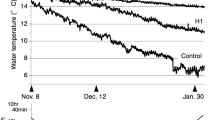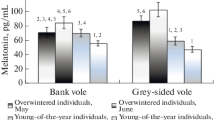Summary
-
1.
Under natural conditions of day-night changes at room temperature (Goettingen/Germany:51° 32′ N.lat.) the spermatogenetic cycle of the lizard (Lacerta sicula campestris Betta) shows an annual periodicity with only one phase of spermiohistogenetic activity. The spermiohistogenesis takes place from the middle of March to the end of June.
-
2.
The reproductive system can be activated prematurely in winter (from middle of December onwards) by long photoperiods and high temperatures.
-
3.
If the lizards are transferred during August or September, i.e. during the regeneration-phase, to a 14∶10-hours L:D-cycle at high temperatures (28–30°C), this combination of stimuli has a strong inhibitory effect on the reproductive system. Thus the animals show refractoriness to long photoperiods at high temperatures during the regeneration-phase in analogy to many birds of temperate zones and some fish.
-
4.
The refractory period terminates at the end of November.
-
5.
As opposed to birds of temperate zones neither decreasing photoperiods nor short days coupled with high temperatures have any effect on the end of the refractory period in this lizard. If, however, the animals are kept for 4 weeks in perpetual darkness and low temperatures (5–6°C) during summer, the regeneration-phase ceases immediately.
-
6.
If in the refractory period long days are combined with low temperatures it is evident that low temperatures are the primary reactivating factor. Short days and perpetual darkness are of secondary importance only.
Zusammenfassung
-
1.
Der Spermatogenesezyklus der Ruineneidechse (Lacerta sicula campestris Betta) weist im natürlichen Tag-Nacht-Wechsel (Standort Göttingen) bei Zimmertemperatur eine Jahresperiodik mit nur einer Phase spermiohisto-genetischer Aktivität (Mitte März bis Ende Juni) auf.
-
2.
Das Fortpflanzungssystem läßt sich schon wieder im Winter (ab Mitte Dezember) durch lange Photoperioden und hohe Temperaturen aktivieren.
-
3.
Überführt man im August oder September — also während der Regenerations-phase — Ruineneidechsen in einen 14: 10stündigen Langtag bei hoher Temperatur, so wirkt diese Reizkombination stark hemmend auf das Fortpflanzungssystem. Die Tiere sind demnach in der Regenerationsphase refraktär gegen lange Lichtzeiten bei hohen Temperaturen wie viele Vögel der gemäßigten Zonen und einige Fsche.
-
4.
Die Refraktärperiode geht Ende November zu Ende.
-
5.
Im Gegensatz zu Vögeln der gemäßigten Zonen haben bei dieser Eidechsenart weder abnehmende Tageslänge, noch Kurztag bei hohen Temperaturen einen Einfluß auf das Ende der Refraktärperiode. Hält man die Tiere aber im Sommer 4 Wochen lang in Dauerdunkel und bei niedriger Temperatur (5–6°C), so ist die Regenerationsphase sofort zu Ende.
-
6.
Spielt man in der Refraktärperiode Langtag gegen niedrige Temperaturen aus, so zeigt sich, daß bei der Ruineneidechse die niedrige Temperatur der primäre reaktivierende Faktor ist. Kurztag und Dauerdunkel sind nur von sekundärer Bedeutung.
Similar content being viewed by others
Literatur
Annan, O.: Experiments on photoperiodic regulation of the testis cycle in two species of the trush genus Hylociohla. Auk 80, 166 (1963).
Aschoff, J.: Jahresperiodik der Fortpflanzung bei Warmblütern. Studium gen. 8, 742 (1955).
Bartholomew, G. A.: Photoperiodism in Reptiles. In: Photoperiodism and related phenomena in plants and animals (ed. R. B. Withrow). Washington, D. C.: AAAS 1959.
Blanchard, B. D., and M. M. Erickson: The cycle in the Gambel sparrow. Univ. Calif. Publ. Zool. 47, 255 (1949).
Burger, J. W.: On the relation of day-length to the phases of testicular involution and inactivity of the spermatogenetic cycle of the starling. J. exp. Zool. 105, 259 (1947).
—: A review of experimental investigations on seasonal reproduction in birds. Wilson Bull. 61, 211 (1949).
—: The effect of photic and psychic stimuli on the reproductive cycle of the male starling, Sturnus vulgaris. J. exp. Zool. 124, 227 (1953).
Dalcq, A.: Etude de la spermatogénèse chez l'Orvet, Anguis fragilis. Arch. Biol. (Liège) 31, 347 (1921).
Emmé, A. M.: Photoperiodic response in reproduction. Russ. Rev. Biol. 1960, 223 (1960).
Farner, D. S.: Circadian systems in the photoperiodic responses of vertebrates. In: Circadian clocks (ed. J. Aschoff). Amsterdam: North-Holland Publ. 1965.
Fischer, K.: Untersuchungen zur Jahresperiodik der Fortpflanzung bei männlichen Ruineneidechsen (Lacerta sicula campestris Betta). Verh. Dtsch. Zool. Ges., Heidelberg 1967. Zool. Anz. 31 Suppl.-Bd. 325 (1968).
Fox, W., and H. C. Dessauer: Response of the male reproductive system of lizards (Anolis carolinensis) to unnatural day-lengths in different seasons. Biol. Bull. 115, 421 (1958).
Harrington, R. W., Jr.: Photoperiodism in fishes in relation to the annual sexual cycle. In: Photoperiodism and related phenomena in plants and animals, (ed. R. B. Withrow). Washington, D. C.: AAAS 1959.
Herlant, M.: Recherches histologiques et expérimentales sur les variations cycliques du testicule et les charactères sexuels secondaires chez les Reptiles. Arch. Biol. (Liège) 44, 347 (1933).
Immelmann, K.: Periodische Vorgänge in der Fortpflanzung tierischer Organismen. Studium gen. 20, 15 (1967).
Laws, D. F.: Hypothalamic neurosecretion in the refractory and postrefractory periods and its relationship to the rate of photoperiodically induced testicular growth in Zonotrichia leucophrys gambelii. Z. Zellforsch. 54, 275 (1961).
Licht, P.: Environmental control of annual testicular cycles in the lizard Anolis carolinensis I. Interaction of light and temperature in the initiation of testicular recrudescence. J. exp. Zool. 165, 505 (1967).
—: Environmental control of annual testicular cycles in the lizard Anolis carolinensis II. Seasonal variations in the effects of photoperiod and temperature on testicular recrudescence. J. exp. Zool. 166, 243 (1967).
Lofts, B., and C. J. F. Coombs: Photoperiodism and the testicular refractory period in the Mallard, J. Zool. 146, 44 (1961).
Marshall, A. J.: Internal and environmental control of breeding. Ibis J. Zool. 101, 456 (1959).
—: Breeding seasons and migration. Biology and comparative Physiology of birds, (ed. A. J. Marshall). New York: Academic Press 1961.
Mayhew, W. W.: Photoperiodic responses in three species of the lizard genus Uma. Herpetologica 20, 95 (1964).
Miller, A. H.: The refractory period in light-induced reproductive development of golden-crowned sparrows. J. exp. Zool. 109, 1 (1948).
—: The occurrence and maintenance of the refractory period in crowned sparrows. Condor 56, 13 (1954).
Riley, G. M.: Light regulation of sexual activity in the male sparrow (Passerd omesticus). Proc. Soc. exp. Biol. (N.Y.) 34, 331 (1937).
Rowan, W.: Relation of light to bird migration and developmental changes. Nature (Lond.) 115, 494 (1925).
Saint Girons, H.: Le cycle reproducteur de la Vipère â Cornes, Cerastes cerastes (L.), dans la nature et en captivité. Bull. Soc. zool. France 87, 41 (1962).
Schildmacher, H.: Der Jahreszyklus des warmblütigen Wirbeltieres. Biol. Beitr. 1, 18 (1961).
Tinkle, D.W., and L. N. Irwin: Lizard reproduction: Refractory period and response to warmth in Uta stansburiana females. Science 184, 1613 (1965).
Vaugien, L.: Influence de l'obscuration temporaire sur la durée de la phase réfractaire du cycle sexuel du moineau domestique. Bull. biol. France et Belg. 88, 294 (1954).
Volsøe, H.: Structure and seasonal variation of the male reproductive organs of Vipern berus. Spolia Zool. Mus. Hauniensis (Copenh.) 5, 172 (1944).
Wolfson, A.: The occurrence and regulation of the refractory period in the gonadal and fat cycles of the Junco. J. exp. Zool. 121, 311 (1952).
—: Role of light and darkness in the regulation of the refractory period in the gonadal and fat cycles of migratory birds. Physiol. Zool. 33, 160 (1959).
—: Regulation of annual periodicity in the migratorial reproduction of birds. Cold Spr. Harb. Symp. quant. Biol. 25, 507 (1960).
Author information
Authors and Affiliations
Additional information
Mit Unterstützung der Deutschen Forschungsgemeinschaft (Fi 78/5 + 6).
Die Arbeit ist ein Teil meiner Habilitationsschrift, die ich am 19. 10. 67 der Mathematisch-Naturwissenschaftlichen Fakultät der Georg-August-Universität zu Göttingen vorlegte.
Rights and permissions
About this article
Cite this article
Fischer, K. Untersuchungen zur Jahresperiodik der Fortpflanzung bei männlichen Ruineneidechsen (Lacerta sicula campestris Betta). Z. Vergl. Physiol. 60, 244–268 (1968). https://doi.org/10.1007/BF00298601
Received:
Issue Date:
DOI: https://doi.org/10.1007/BF00298601




